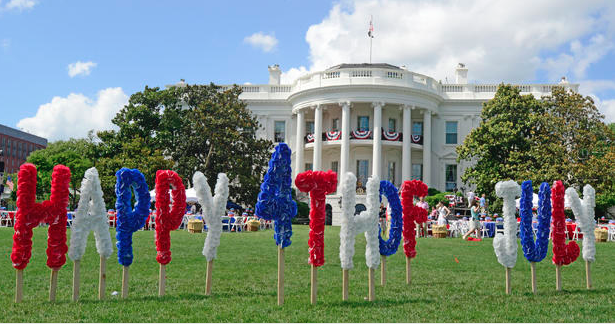
The Fourth of July on the White House South Lawn. (WH)
Since that day of July 4, 1776. when its independence was first declared by the American colonies upon the ratification of the Declaration of Independence, the United States has marked Independence Day for 240 years.
It was only thirteen years later that the American presidency was established and the Fourth of July began to be observed in various ways by presidential households.
For nearly two-hundred thirty years now, at either the White House in Washington, D.C. or the “Summer White House,” those rented or owned private retreats of presidential families, the July Fourth holiday proved important to several First Ladies for reasons that ranged from private grief to benchmarks in their public roles.
Dolley Madison, 1808
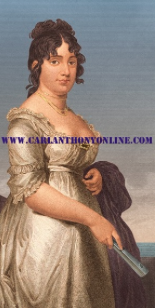
Dolley Madison. (carlanthonyonline)
Her husband had not yet been elected the fourth president in his own right and the later, persistent crediting to her of serving as the third president’s official White House hostess are a misnomer, but the Fourth of July in 1802 was a watershed moment for Dolley Madison.
With both President Jefferson and Vice President Aaron Burr being widowers, her status as the spouse of the Secretary of State, the Cabinet member of highest rank, converged with her natural ease with crowds to forge her into one of the nation’s few female public figures.
Mrs. Madison was a prominent figure among the crowds invited by President Jefferson to his open-house Independence Day reception.
One year, she used the event to solicit prominent women of the city, in her effort to spearhead a private fundraising effort to help compensate the federal government funding of the western exploration by Lewis and Clark.
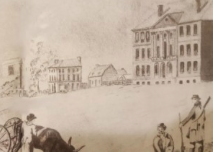
An 1803 watercolor of the White House also shows nearby the first residences of F Street, where the Madisons lived (Huntington Library)
It was in 1808 that Dolley Madison was given the highest honor and made a bit of feminist history.
A band and cavalry contingent stopped outside the private home of Secretary Madison to serenade his wife.
Dolley Madison then presented them with a ceremonial flag and delivered a “patriotic address” related to Independence Day, the first woman known to make a public July 4th speech.
Sarah Polk, 1848

Sarah Polk. (Polk Home)
In 1848, incumbent Sarah Polk hosted a unique Fourth of July gathering of her First Lady sorority, welcoming among guests her elderly predecessors Dolley Madison and Louisa Adams.
The two presidential widows had joined with Betsey Hamilton, widow of Founding Father Alexander Hamilton in heading up a women’s committee that was part of a larger national organization raising funds for the groundbreaking and initial construction of the long-anticipated Washington Monument.
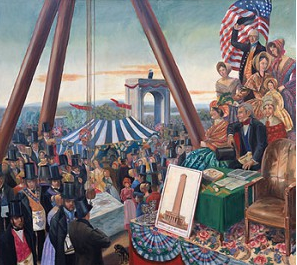
This watercolor illustrates the Washington Monument cornerstone-laying ceremony. (Scottish Rite Temple)
The drive proved so successful that the laying of the cornerstone ceremony was scheduled for Independence Day that year.After appearing at the outdoor ceremony beneath a striped tent on the grounds south of the White House, the two former First Ladies joined Mrs. Polk for a reception in their old home. It is the first known gathering of multiple First Ladies at a public event.
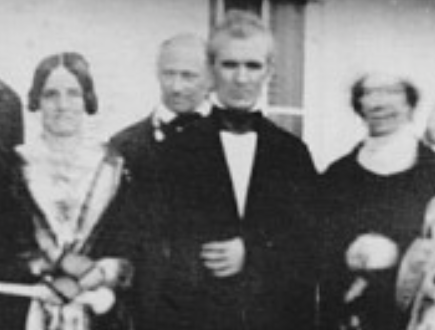
The President and Mrs. Polk joined by former First Lady Dolley Madisont. (Eastman House)
What could not be known to the three First Ladies at the time, however, was that a future presidential hostess was also in attendance, Harriet Lane, the young niece of Polk’s Secretary of State James Buchanan.
While a certain Illinois Congressman was also among the crowd at the ceremony, his wife Mary Lincoln is recorded as having already left the city.
Peggy Taylor, 1849
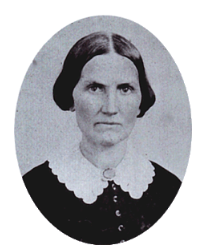
Peggy Taylor. (NFLL)
Forever a shadowy figure in her husband’s brief sixteen-month presidency, the wife of Zachary Taylor had arranged with her youngest daughter Betty to essentially divide the First Lady role into private and public responsibilities.
Peggy Taylor would serve as hostess at private dinners, where visiting family members and political figures she knew personally were guests.
Betty Taylor Bliss would serve as the public First Lady, promenading at open-house and diplomatic receptions on the arm of her father, greeting guests and seated at dinners with the status of the presidential lady.
On the first Fourth of July of the administration, however, Peggy Taylor agreed to make a rare public appearance in the large East Room, so she could join the President in welcoming the teachers and students of the local Sunday School Union.
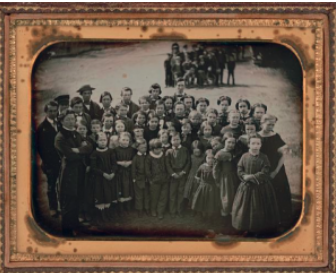
A Sunday School Union group in 1849, the year such a group were received by Mrs. Taylor on July Fourth. (Pinterest)
While she was able to leave the executive mansion on a nearly daily basis and go unrecognized across the public square to attend midday religious services at St. John’s Episcopal Church, on this Fourth of July, Peggy Taylor was willing to temporarily sacrifice her anonymity and accept the gift of a Bible from the Baptist organization.
Little could she know that the next year’s Fourth of July ceremonies would find her husband overeating and contracting a likely bacterial infection, leading to his sudden death days later.
Jane Pierce, 1855

Jane Pierce. (LC)
While always conscious of the tragic death of her young son in the weeks preceding her move to the White House, Jane Pierce also recognized how her mood could impede what she respected as the public’s right to enjoy the grounds of the presidential mansion on the Fourth of July.
Due to her religious belief that the Lord’s Day must be spent in silent prayer, she was initially adamant about rescheduling the customary Sunday public concerts played by the Marine Band from the White House South Balcony. Reaction was not entirely sympathetic.
When she joined the President for what was intended as a brief few days away from Washington at Cape May, New Jersey at the end of June, Mrs. Pierce convinced him to extend their vacation for another week.

The Congress Hall Hotel where Jane Pierce spent her July Fourth. (Pinterest)
Content with the presidential suite provided them at the Congress Hall Hotel, the First Lady kept them there until the July Fourth holiday was over in Washington, permitting the large citizenry gathered there for massive fireworks staged from the Navy Yard to make as loud a ruckus on the South Lawn as they wanted, while sparing her all the noise and crowds.
She returned three days after the holiday when she was assured that most of the masses had dissipated.
Julia Grant, 1876
As the two terms of the Grant Administration wound down into its last months, the First Lady remained as eager as ever to defend not only her husband’s conduct as president but the greatness of the nation over which he ruled.

Julia Grant.
Her pride especially came to the fore during the Centennial Exhibition in Philadelphia, a display of Industrial Age America’s technological innovations and ingenuity. Although she spent the actual centennial day with her family in the White House, Mrs. Grant intended a highly visible presence for herself at the May 10 opening day of the exhibition.
When the empress of Brazil was invited to place her hand along with that of her husband and President Grant on the great Corliss Engine which powered all of the mechanical exhibits, Julia Grant was livid.
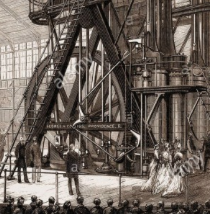
Julia Grant, the empress of Brazil and other wives of officials on the platform of the mammoth engine that set the machinery of the Centennial Exposition in motion. (LC)
“I wondered what could have prompted this discourtesy to the wife of the President of the United States,” she later recalled.
The First Lady got her chance to shine, however. When she and the emperor came upon a large exhibit of American tobacco, he doubted it could have much worth. She retorted that it was an especially helpful aid for digestion.
The emperor quipped that rigorous physical exercise was the best way to aid digestion.
“Oh, Your Majesty, you are quite away behind the times,” the First Lady patriotically pointed out. “The whole energies of the United States are now bent upon inventing labor-saving devices.”
Lucretia Garfield, 1881
It was only one month after her husband’s presidential inauguration that Lucretia Garfield fell deathly ill with the malaria that plagued generations of White House residents, resulting from the mosquito breeding grounds in the swamps just south of the executive mansion.
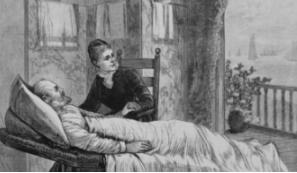
Lucretia Garfield took charge of her wounded husband’s sickroom by the time she’d returned to the White House on the Fourth of July 1881. (LC)
Once she was considered strong enough to be physically moved from her bedroom on June 18, the First Lady preceded her husband and two eldest sons by taking in the fresh salt air and cooler temperatures of a retreat established for the family at Elberon, New Jersey.
The entire family was scheduled to spend the July Fourth holiday together there and the President headed with his sons to join his wife a few days before, with a speech at Williams College.
President Garfield got no further than the train depot station, being shot point blank by a disappointed office-seeker Charles Guiteau.

The Jersey shore mansion where Lucretia Garfield was recuperating when, the morning before July Fourth, she rushed back to her wounded husband’s side in Washington. She later brought him here, where he died. (longbranchhistory.org)
In the early morning hours the day before Independence Day, the First Lady was being sped by train back down to Washington.
On the Fourth of July that year, having composed her initially overwhelmed reaction, she took control of the chaos in a bedroom that was hastily-organized into a hospital ward, dismissing even the President’s belief he would soon die from the bullet wounds.
“Well, my dear, you are not going to die as I am here to nurse you back to life; so please do not speak again of death.”
Sadly, not even Crete Garfield’s determined optimism could alter his fate, the President dying two months later with his wife at his side.
Florence Harding, 1922
President Warren Harding and First Lady Florence Harding had not been home to Marion, Ohio since they had entered the White House for a year and a half but when they finally came back it was for an especially meaningful occasion.
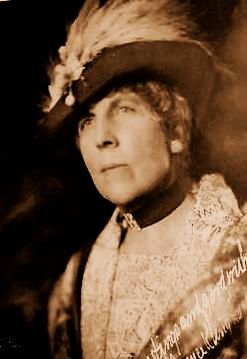
Florence Harding.
It was not only the Fourth of July but, in 1922, the centennial celebration of the small town where they had met, married and built a newspaper business.
Unlike previous presidents who had travelled distances almost exclusively by train, the Hardings especially loved driving.
So, on the morning of July 3, 1922 they took off from Washington, D.C. in a caravan of cars, driving over two hundred miles along a route which took them past the homes of striking coal miners who nevertheless were out to greet them with waving flags.
The Hardings arrived in Marion at 10:30 that night and went directly to the home of his father, who would be their host, their own home then being privately leased to a local family.
On the morning of the Fourth of July, Florence Harding enjoyed a motor drive through her town in a limousine emblazoned with the presidential seal, along the blacktop streets, vigorously waving her arm to old friends and neighbors along the way.
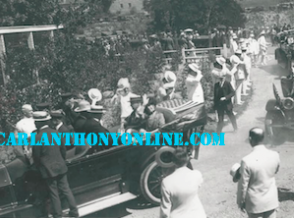
Warren and Florence Harding riding in an open car on the Fourth of July in 1923, celebrating the holiday in Oregon, (carlanthonyonline)
After a parade review, her highest point of pride was being driven with her husband into the local fairgrounds where centennial celebration ceremonies were combined with the Fourth of July festivities.

Florence Harding waves to cheering admirers. (carlanthonyonline)
Unlike the President, the First Lady had been born and raised in Marion and she was loved there. The band honored her with the playing of “Flo From Ohio,” a song written during the campaign. Not even the presence of Carrie Phillips in the crowd, the known former mistress of her husband, could dim her spirits.
The President told the crowds, “And now I want to introduce you to the best scout a fellow ever had – my wife.”
As she looked around the fairgrounds, the First Lady could not help but reflect back on her earlier times there, during an often troubled youth under the thumb of her controlling father.

Warren and Florence Harding at a Washington horse show. (pinterest)
She wasn’t sure if she was more “proud and happy” to return to the fairgrounds as First Lady, “or when I used to ride up on my white horse to the judges’ stand at the same spot years ago to receive the blue ribbon.”
At a Fourth of July reception held afterwards, she enjoyed a conversation with the young blond woman she’d known as a child, Nan Britton; unknown to the First Lady was the fact that her husband had fathered a daughter by Britton three years earlier.
“Yes indeed,” she told Britton, “I keep Warren Harding the best-dressed man in Washington.”
Grace Coolidge, 1924
The Fourth of July had always been an especially celebratory holiday for Grace Coolidge, given that it was also her husband’s birthday.

Grace Coolidge at a summer garden party eating ice cream. (LC)
The day before the national holiday, however, the First Lady noticed how listless her 16 year old son Calvin had become. It was more than tiredness after playing tennis.
In fact, not wearing socks during the game he developed a blister that quickly became infected.
The White House physician was called in and took blood samples to be examined at Walter Reed Hospital. The tests confirmed that the younger First Son had a serious and rapidly growing blood infection.
On Independence Day, Grace Coolidge spent Independence Day confined to her son’s bedroom, comforting him and remaining optimistic as she recalled the many dangerous childhood illnesses he had survived, and helping the nurses on duty.

Grace Coolidge and her son Cal at home in 1920 (left) and at the White House in 1924. (Boston Public Library, LC)
The next day, the White House announced that the president’s son was in dangerous condition.
On July 6, when she entered the White House car that followed the ambulance that rushed her son to Walter Reed Hospital for an operation attempting to draw the poisoned blood from his system, the typically rosy-cheeked and smiling First Lady was ashen and grave.
All the best medical efforts were employed to save the life of the President’s son, from saline injections to blood transfusions.
Grace Coolidge and her husband kept a vigil through the night at the side of Cal Jr.’s hospital bed, as he became delirious and then sank into a coma.

Calvin and Grace Coolidge at their son’s gravesite. (LC)
On the morning of July 7, they returned briefly to the White House to shower and change, then returned to the hospital and remained all day, helpless as they watched their son die later that day.
Less than a week after the Fourth of July, he was buried in the family plot in Vermont where, with the public held at a distance, Grace Coolidge finally gave way to weeping.
Although her public persona had already been shaped by her naturally optimistic perspective on life, it was a reminder that, no matter how positive a spin the White House might make things appear, those who live there suffer the same unexpected challenges and tragedies as everyone else.
Bess Truman, 1945
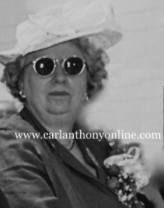
Not even a pair of sunglasses could shield Bess Truman from unwanted public attention.
When her husband, as vice president, had to assume the presidency upon the death of President Franklin D. Roosevelt in April of 1945, Bess Truman was first overwhelmed with sadness and uncertainty about what she would do as a public figure.
Within months of serving as First Lady, she seethed with resentment about having to sacrifice the anonymity she’d enjoyed as a Senator’s spouse for the decade preceding her move to the White House.
Insisting on maintaining whatever vestige of private life that hadn’t yet been overwhelmed by the media, she left the President alone in the capital city and retreated to her family’s Victorian mansion in Independence, Missouri.
Using the excuse that she had to attend to her ailing and querulous old mother and oversee previously-scheduled renovations to the mansion, Bess Truman fumed about the curious citizenry staring at the closed windows of the house hoping to glimpse her and lingering newspaper reporters and photographers who skulked around the small town trying to chat locals up for human interest anecdotes about her.
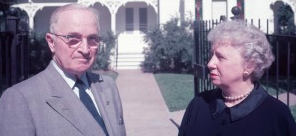
Harry and Bess Truman in front of their Missouri home. (NPS)
She seemed to stir at the idea of sharing the Fourth of July with the President, who promised to come home after attending the concluding session of the United Nations in San Francisco.
Instead of fireworks in the sky, there were fireworks in their home, the Trumans bickering about the fact that he could not linger long but had to make his way back to Washington and from there leave on July 5th for the Potsdam conference.
Angered at him for this, when the President asked her to come out on the front porch and pose with him for national news wire service photographers, she flatly refused. “All I’ve ever tried to do is make you pleased with me and the world,” he griped in reaction.
Jacqueline Kennedy, 1963
In the final months of the pregnancy of the president’s wife, a nationally novel condition that no American under the age of 80 had ever known, Jacqueline Kennedy warned her White House staff that she’d be “taking the veil.”
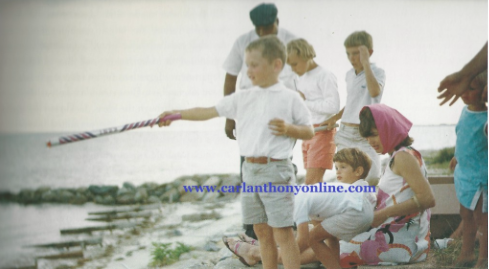
Jackie Kennedy with her son and several nephews at Cape Cod, July 4, 1963.
She worked diligently all through the winter and spring months, putting into place the permanent infrastructure that would continue her massivc undertaking of turning the White House and its furnishing collections into one of genuine historical significance and which would continue long after her husband’s presidency as over. She streamlined the process of planning a state dinner to her unique tastes of flowers, china, tablecloths, entertainment and protocol form. She signed off on the text copy of what would be the second published book she wanted printed and sold to the public related to the house’s history, this one being biographies and portraits of all the Presidents.
Finally, as the first days of summer began in late June of 1963, the six-month pregnant Jacqueline Kennedy turned over the running of the First Lady’s office to her trusted, lifelong confidante Nancy Tuckerman who had taken on the job of Social Secretary that month.
Mrs. Kennedy would be out of the White House for the next three months, spending the whole summer at a rented home on Squaw Island at Cape Cod, near the larger Kennedy family compound of homes.
With Nancy sending cup work folders with correspondence and other matters requiring her decisions, she would continue working but reduce her hours, resting in order to be ready to give birth to her child, expected in September.
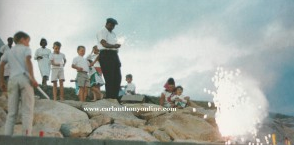
Jackie Kennedy holds her son John as they watch a bundle of sparklers flaming on Independence Day.
The First Lady arrived with her two children on July 2. She would be joined by President Kennedy in time to celebrate the actual July Fourth holiday, he arriving by helicopter in the early evening. In the hours before he was with her, Jackie Kennedy headed out to a jetty of rocks extending into the sea, playing with her son John, and being joined by several of her nephews, including Robert F. Kennedy, Jr. and William Smith.
Barefoot, clad in a loose, flowered sundress and her ubiquitous headscarf , the First Lady watched as a family handyman lit rockets, sparklers and firecrackers for the enjoyment of the boys. With her son on her lap, she seemed especially attentive to him. One observer at the time pointed out the sense of optimism during the holiday with her was pervasive. Not only was she expecting her third child, but that day, her sister-in-law Ethel had given birth to another child and her sister-in-law Eunice Shriver told the family that day that she was also pregnant.
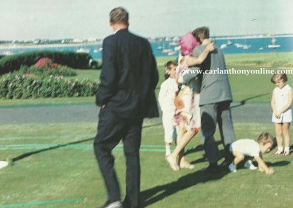
The Kennedys in a rare public display of affection on the Fourth of July, 1963.
When the President set foot on the ground and saw his wife, they did something they almost never did – they embraced and kissed passionately, without their usual regard for being watched by Secret Service agents and White House photographers in even this fleeting act of intimacy.
Later that night, Jackie Kennedy joined her extended family in the basement movie theater of the “big house” owned and occupied by the President’s parents. There they all watched color movies made of the President’s recent trip to Ireland.
The First Lady had deeply regretted not being there, frustrated that her cautious obstetrician had refused to let her make the overseas trip. Th holiday ended with Jackie Kennedy joining everyone out on the big green lawn overlooking the ocean, where a larger fireworks display was put on for them.
Given the sense of hope that Independence Day ended on, it would be hard to reconcile it with the next four months when Mrs. Kennedy would give premature birth to a son who only lived two days and when her husband would be assassinated, seated right beside her.
Nancy Reagan, 1981
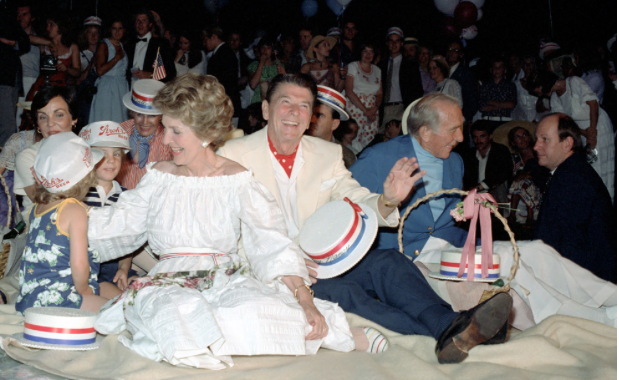
The President helped make Nancy Reagan’s first Fourth of July birthday as First Lady a relief from her anxieties. They take in fireworks with friends on the White House South Lawn, 1`981. (RRPL)
Her first six months as First Lady may have been cast as the start of a glorious, glamorous, glitzy administration in the popular imagination, but for Nancy Reagan as a real person it was one shock after another.
In one of her first print interviews she made the honest but politically naive declaration that her priority was refurbishing the private living quarters as a “nest” for the president by soliciting private donations at a time of economic recession.
This prompted a dark caricature of her as being insensitive to the masses of unemployed citizens that made her the unwitting lightening rod for administration critics.
Her couture wardrobe furthered this, to be solidified by her attending the British royal wedding.

Nancy Reagan blows out her July Fourth birthday cake candles. (RRPL)
It was the nearly-fatal assassination attempt on her husband’s life in March, however, that set the new First Lady off into a state of perpetual low-grade anxiety about his safety among the public and in open spaces.
To distract her, the President determined to make her first birthday as First Lady a memorably convivial one. Although born two days after the holiday, in 1981 she was feted on her 60th birthday with the surprise presence of her close circle of California friends, who joined her in an afternoon White House luncheon, topped by a large white birthday cake.
Later that evening, she hosted the first White House Fourth of July picnic in many a decade, for the executive and domestic staffs and their families. Mrs. Reagan watched the fireworks with the President from a picnic blanket on the South Lawn.
Michelle Obama, 2010, 2011, 2012, 2014, 2015
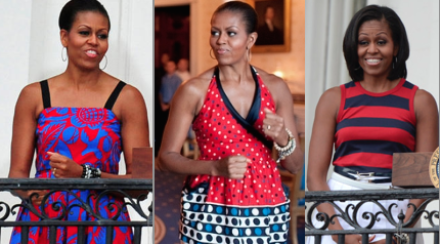
The fashionable First Lady’s Fourth of July wardrobes worn to three of the public celebrations she hosted with the President. (WH)
The incumbent First Lady seems to hold the record among her predecessors for celebrating the Fourth of July holiday at the White House with not only her family but invited members of the public.
Recognizing the holiday as a chance to honor the members of the military and their families, the well-being of whom has been one of her two primary focuses as First Lady, Michelle Obama arranged for several hundred of them to come in the afternoon to first enjoy a barbecue picnic, and then entertained by leading contemporary performers.
She and the President have also come to the South Balcony to offer their words of welcome to the crowd before joining them on the lawn picnic blankets.

Michelle Obama welcomed military families for White House Fourth of July celebration throughout her tenure. (WH)
As the dark of evening set in, Mrs. Obama has sat with the President and the crowds to take in the spectacular fireworks display exploding above the nearby Washington Monument.
Historically, most First Ladies have joined their husbands at private homes in the mountains or at the shore to spend the Fourth of July weekend, but judging from her enthusiasm as she interacted with hundreds of guests, Michelle Obama has preferred spending the nation’s birthday in the nation’s house.
Categories: First Ladies, Holidays, Independence Day, Presidential Holidays
Tags: Bess Truman, Dolley Madison, Florence Harding, Grace Coolidge, Jacqueline Kennedy, Michelle Obama, Nancy Reagan
 Jackie & The Nixons: Mrs. Kennedy Returns to the White House, With New Images of the Visit
Jackie & The Nixons: Mrs. Kennedy Returns to the White House, With New Images of the Visit  Jane & Jill, Potential First Ladies: Lots in Common Between the Wives of Joe Biden & Bernie Sanders
Jane & Jill, Potential First Ladies: Lots in Common Between the Wives of Joe Biden & Bernie Sanders  All The Presidents’ Birthdays: Dance Balls to Movie Star Fundraisers in 90 Rare Photos
All The Presidents’ Birthdays: Dance Balls to Movie Star Fundraisers in 90 Rare Photos  The First White House Valentine’s Day Dance: the McKinleys, Ragtime, Racism & The Romance of the “Ghost Girls”
The First White House Valentine’s Day Dance: the McKinleys, Ragtime, Racism & The Romance of the “Ghost Girls”  Liz Taylor Meets Jackie Kennedy: Tabloid Fantasy to Chance Encounter & The Only Photos of Them Together, Part II
Liz Taylor Meets Jackie Kennedy: Tabloid Fantasy to Chance Encounter & The Only Photos of Them Together, Part II  The Santa Claus You Must Never See, If Yule Dare
The Santa Claus You Must Never See, If Yule Dare
Leave a Reply